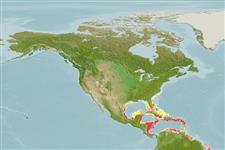Iotrochota arenosa Rützler, Maldonado, Piantoni & Riesgo, 2007
| Native range | All suitable habitat | Point map | Year 2050 |

|
| This map was computer-generated and has not yet been reviewed. |
| Iotrochota arenosa AquaMaps Data sources: GBIF OBIS |
Upload your photos
Google image |
No photo available for this species.No drawings available for Iotrochotidae.
Google image |
No photo available for this species.
Classification / Names Common names | Synonyms | CoL | ITIS | WoRMS
Demospongiae | Poecilosclerida | Iotrochotidae
Environment: milieu / climate zone / depth range / distribution range Ecology
Sessile. Tropical
Distribution Countries | FAO areas | Ecosystems | Occurrences | Introductions
Western Central Atlantic.
Length at first maturity / Size / Weight / Age
Maturity: Lm ? range ? - ? cm
Short description Morphology
Thick encrustations on an accumulation of sand and rubble, seemingly partly buried. Surface dirty with sediment. Feels rugged when handled, but appears smooth when dermis is stretched. Black in situ, dark purple when stored. Surface is soft, fibers tough. Purple mucus exudate that stains the hands. Oscules not apparent (Ref. 85482).
Found in sand and rubble on coral reefs. Also in lagoons, mangroves, and pilings. Known from depths between 0.1 to 45 m (Ref. 85482).
Life cycle and mating behavior Maturity | Reproduction | Spawning | Eggs | Fecundity | Larvae
Members of the class Demospongiae are hermaphroditic. Life cycle: The zygote develops into parenchymella larva (free-swimming) before settling down on a substrate where it grows into a young sponge.
Main reference
References | Coordinator | Collaborators
Zea, S., T.P. Henkel and J.R. Pawlik. 2009. (Ref. 81728)
IUCN Red List Status (Ref. 130435)
CITES status (Ref. 108899)
Not Evaluated
CMS (Ref. 116361)
Not Evaluated
Threat to humans
Harmless
Human uses
| FishSource |
Tools
More information
Internet sources
BHL | BOLD Systems | CISTI | DiscoverLife | FAO(Publication : search) | Fishipedia | GenBank (genome, nucleotide) | GloBI | Gomexsi | Google Books | Google Scholar | Google | PubMed | Tree of Life | Wikipedia (Go, Search) | Zoological Record


